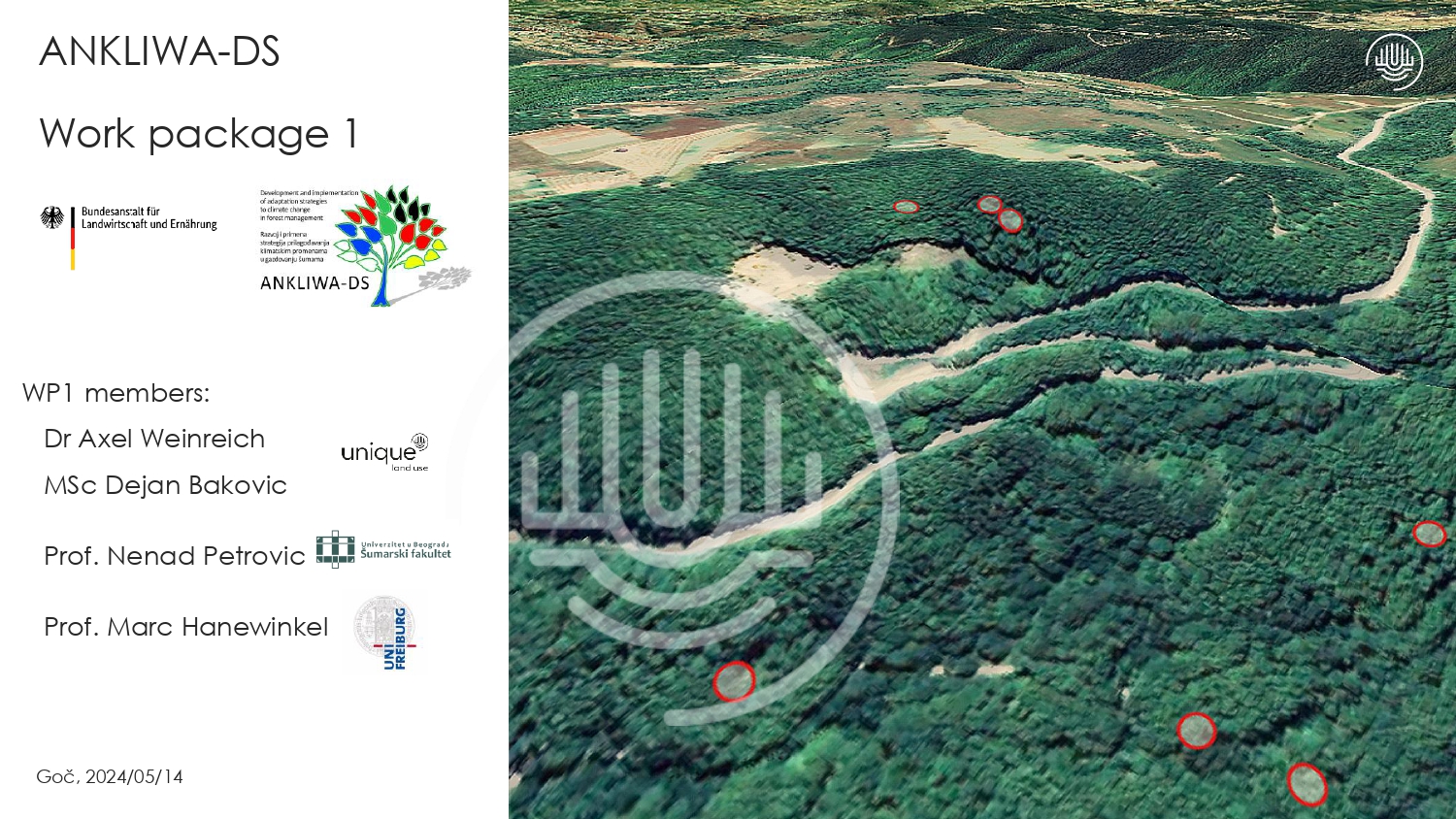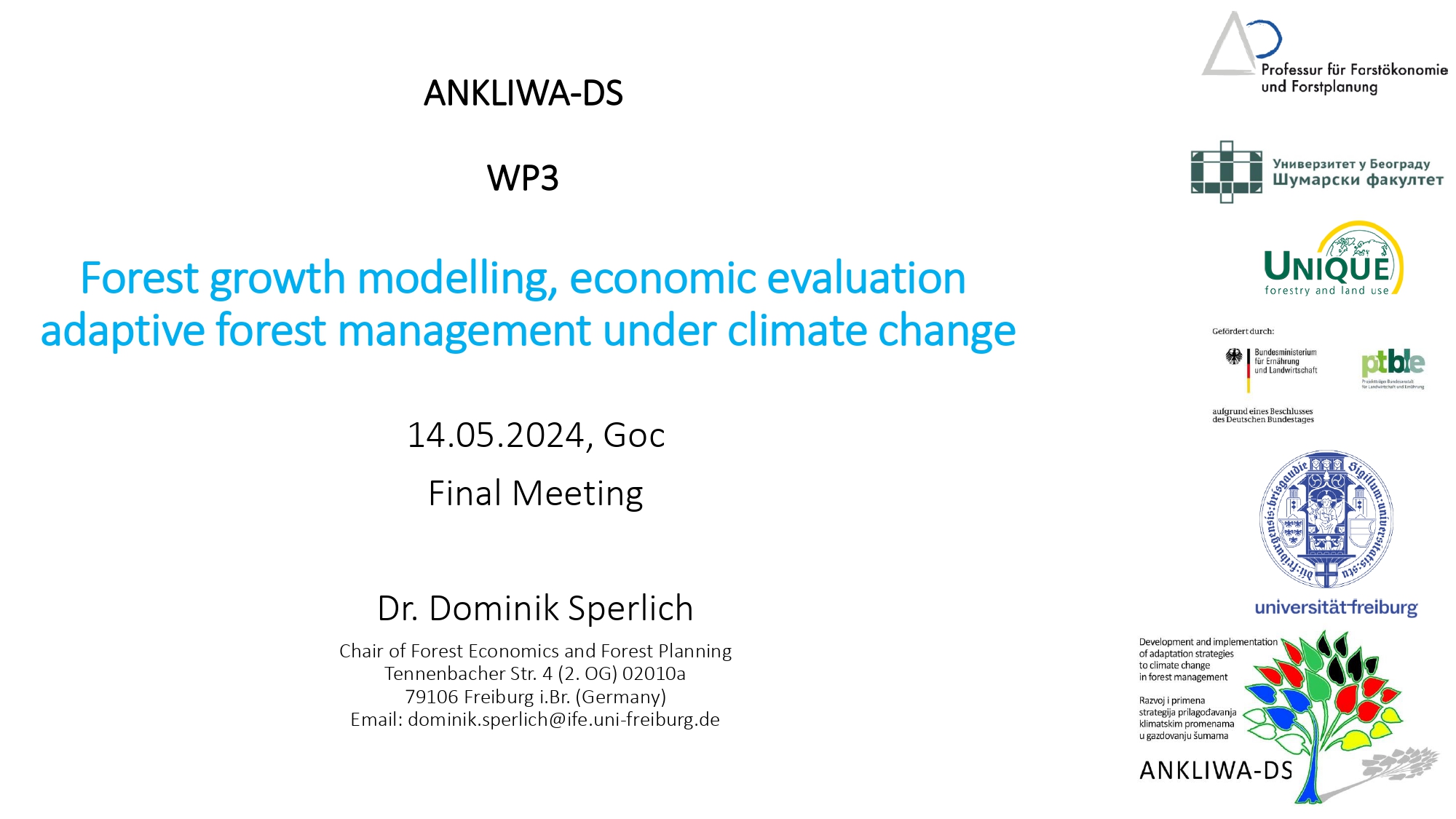| 1 |
Gains or loss in forest productivity under climate change? The uncertainty of CO2-fertilization and climate effects. Climate (Article)
|
WP3 |
30 November 2020. |
We studied the growth, productivity and mortality of beech (Fagus sylvatica L.) and fir (Abies alba Mill.) in the Black Forest (Germany) under three climate change scenarios (representative concentration pathways (RCP): RCP2.6, RCP4.5, RCP8.5) using the detailed biogeochemical forest growth model GOTILWA+. Concluding, cultivation of beech and fir may still be possible in the study region, although severe productivity losses can be expected in the coming decades, which will strongly depend on the dampening CO2 fertilization effect. |
 |
| 2 |
Development of digital site mapping and estimating future tree species suitability in Ser-bia. Risk analysis (Presentation)
|
WP2-5 |
01 June 2022. |
Aiming at a moving target – how to implement forest adaptation strategies to climate change under socio-, economic and ecological uncertainties? A case study from Serbia. |
 |
| 3 |
ANKLIWA-DS project background. Promotion (Presentation)
|
WP2-5 |
November 2021 |
Project concept description. |
 |
| 4 |
Anthropogenic land-use legacies underpin climate change-related risks to forest ecosystems. Climate (Article)
|
WP2-4 |
October 2023. |
Anthropogenic land-use legacies that persist in forest properties following the alteration in forest distribution, structure, and composition can interact with climate change stressors and lead to detrimental ecological effects. |
 |
| 5 |
Aiming at a moving target: Economic evaluation of adaptation strategies under the uncertainty of climate change and CO2-fertilization. Forest economics (Article)
|
WP2-4 |
15 January 2024. |
Drought severely worsened till 2100 and eventually outplayed growth-enhancing CO2 fertilization turning productivity gains into losses for beech and fir. Most scenarios generated notable losses in profitability but economic tipping points were later than for productivity due to lag effects related to discounting. |
 |
| 6 |
Content and scope of pedological research for forest sites mapping. Soil (Article)
|
WP2 |
21-24 September 2021. |
Implementation of Forest Sites Mapping Methodology in the Republic of Serbia. The concept of forest habitat mapping enables users of forest ecosystem services to react in a timely manner by choosing species that can survive in the changed climatic conditions of the habitat. |
 |
| 7 |
Ecological and floristic characteristics of new montpellier maple (Acer monspessulanum L.) site in the locality Glogovita kosa on Mt. Boranja. Site index (Article)
|
WP2 |
2021. |
A new motpellier maple (Acer monspessulanum L.) site was described in this paper, located on mountain Boranja. The community is of azonal character, orographically-edaphically conditioned, and occurs in warmer aspects, on shallow and skeletal rendzina on oolithic limestones. |
 |
| 8 |
Dynamic height growth models for highly productive pedunculate oak (Quercus robur L.) stands: explicit mapping of site index classification in Serbia. Forest productivity (Article)
|
WP3 |
26 March 2024. |
We applied the generalized algebraic difference approach (GADA) to develop dynamic models of height growth for pedunculate oak (Quercus robur L.) in Serbia. According to the dominant heights, the studied region comprises some of Europe’s most productive sites for pedunculate oak. Therein, we have generated a map showing the current site index class of stands. Such a map could be used to enhance forest management and evaluate climate change impacts. |
 |
| 9 |
Site index curves for peduncululate oak (Quercus robur L.) in Srem region of Serbia: mapping the current site productivity as reference point for risk analysis. Risk analysis (Poster)
|
WP3 |
|
Development of the first dynamic site index curves (SI) for the pedunculate oak in the Srem region of Serbia. Creating the spatially continuous productivity map covering a total of 22 management units. |
 |
| 10 |
Development of digital site mapping and estimating future tree species suitability in Serbia. Site index (Poster)
|
WP2 |
31 May-2 June 2022. |
The division of forest area into site types, representing homogeneous spatial units in terms of vegetation, soil, climate, and position (terrain, slope, and exposure) is ecologically relevant and essential for forest planning and management. The selection of site types can be based on the synthesis of site data, i.e. based on combining soil water balance level (WBL) and soil nutrient regime (NR) of a certain area. |
 |
| 11 |
Climate change impacts on management and activities in protected areas: Managers and stakeholders attitudes. Forest policy (Poster)
| WP5 |
|
Climate changes already have a significant impact on protected areas in Serbia. The research results may indicate the possibility that climate change issues are not fully accepted at all levels of protected
area management systems. |
 |
| 12 |
Forest adaptation strategies to climate change under socio-ecological, & economic uncertainties - a case study from Serbia. Promotion (Poster)
| WP1-5 |
23-29 June 2024. |
Serbia has been identified as a climate change hotspot, highlighting a significant science gap due to the lack of essential data, models, yield tables, and suitability maps. This gap creates a high level of uncertainty for decision-makers, underscoring the urgent need for comprehensive forest management directives and a robust governance framework to address the challenges posed by climate change. |
 |
| 13 |
Measures and activities for managing protected areas under climate chang-es: The analysis of regulatory frameworks in selected countries of central and southeast Europe.
| WP5 |
January 2021. |
The paper analyses regulatory frameworks (strategies and laws) in the field of nature conservation and forestry, i.e. measures and activities for managing protected areas under climate changes in selected countries of central and southeast Europe. |
 |
| 14 |
Coordination, Project management, Interaction with stakeholders, Project implementation (Presentation).
| WP1 |
14 May 2024. |
WP - presentation at final conference. |
 |
| 15 |
Development of a modern digital site mapping, focusing on site vegetation analysis and tree species suitability analysis (Presentation).
| WP2 |
14 May 2024. |
WP - presentation at final conference. |
 ENG_page-0001.jpg) |
| 16 |
Development of a climate-sensitive growth simulation model with economic component for the main tree species in Serbia and forest treatment strategies as basis for the decision-making of forest management under climate change (Presentation).
| WP3 |
14 May 2024. |
WP - presentation at final conference. |
 |
| 17 |
Dynamic tree species Distribution and productivity maps under climate change (Presentation).
| WP4 |
14 May 2024. |
WP - presentation at final conference. |
 |
| 18 |
Climate change governance and sustainable development in Serbia (Presentation).
| WP5 |
14 May 2024. |
WP - presentation at final conference. |
.jpg) |